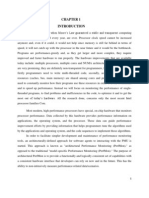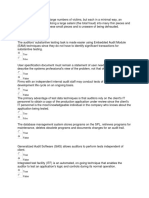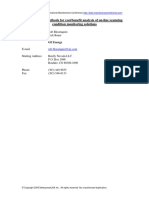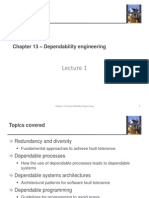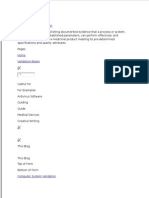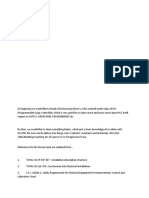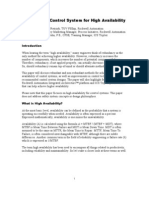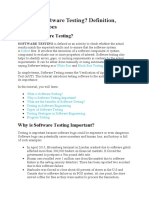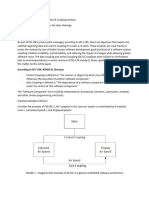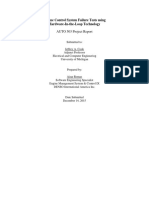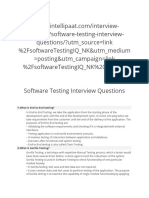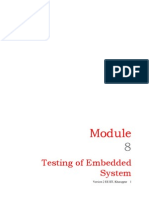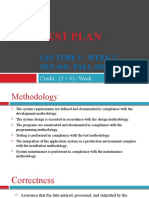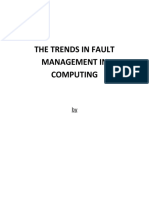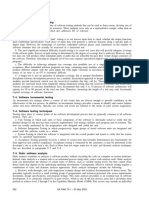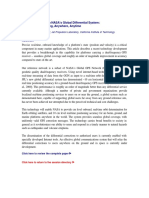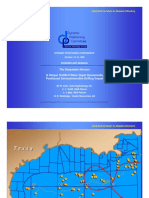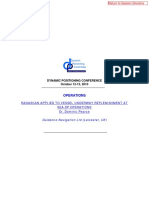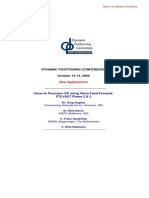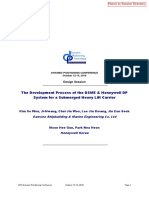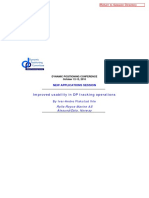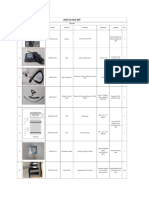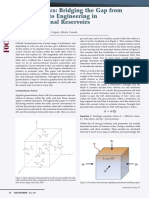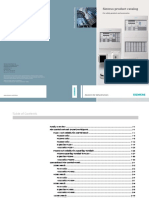System Verification Helps Validate Complex Integrated Systems
System Verification Helps Validate Complex Integrated Systems
Uploaded by
Xa MauCopyright:
Available Formats
System Verification Helps Validate Complex Integrated Systems
System Verification Helps Validate Complex Integrated Systems
Uploaded by
Xa MauOriginal Description:
Original Title
Copyright
Available Formats
Share this document
Did you find this document useful?
Is this content inappropriate?
Copyright:
Available Formats
System Verification Helps Validate Complex Integrated Systems
System Verification Helps Validate Complex Integrated Systems
Uploaded by
Xa MauCopyright:
Available Formats
DYNAMIC POSITIONING CONFERENCE
October 14-15, 2014
RELIABILITY SESSION
System Verification Helps Validate Complex Integrated
Systems
By Naveen Selvam
American Bureau of Shipping (ABS)
Return to Session Directory
Naveen Selvam
Reliability
System Verification helps validate complex integrated systems
Abstract
As building and operating offshore assets become more complex, and more integrated, one of the biggest
challenges is centered on software. The move toward automation of offshore assets has allowed drilling
and production systems to work much more efficiently. However, the introduction of complex, integrated
control systems also poses new challenges. These systems can present enormous problems during
operations and maintenance without thorough testing of the software. Hardware-In-the-Loop (HIL)
testing is one option used for testing software actions and for crew training. This paper provides insights
into the usefulness of HIL test and the benefits it had on a recently completed drillship.
Computer-based control of nearly all equipment onboard marine and offshore assets is ubiquitous,
offering increased safety and efficiency but at the cost of increased complexity and increased risks of a
failure with the associated consequences. Verifying system integrity is critical to identifying and
mitigating system failure to safeguard marine and offshore operations. HIL testing is a method that is
used in the development and testing of complex real-time integrated systems. Greater understanding
resulting from such testing can be used for risk reduction and crew training by evaluating whether the
system performs as expected or whether there may be a safer action to mitigate or manage the failure in a
better manner.
The marine and offshore industries are realizing the important role of software in controlling the actions
of the equipment aboard and especially the actions of the equipment upon a failure. Software verification
allows assessment of the equipment during normal, degraded, and failed states. This assessment allows
for the identification and mitigation of safety, business and environmental risks with a bonus of providing
useful training for the crew. The owners of these assets are requesting some form of guidance in testing
these complex control systems. Improved software quality through the use of standardized methodology
provides assertion that today's complex systems perform as intended and as expected. The best method is
using HIL testing with a detailed verification plan. HIL testing allows for discovering faults before
deployment, leading to lower costs and lower risks of any schedule impacts. Additionally, software HIL
testing is possible after commissioning for software updates and modifications made during
commissioning and beyond. System verification testing can be applied after the system has been installed
on existing assets.
Safety and reliability of integrated software-dependent systems is now becoming an industry demand. A
control system interacts not only with the operator but also with the numerous connected control systems,
input and outputs, as well as the data sources. Cascade failures are possible with integrated systems,
resulting in faltering operations, reducing efficiency, and increasing non-productive time (NPT).
Integrated software testing using the HIL method may help prevent these failures. The system verification
process addresses these challenges and provides guidance for properly testing the control systems. By
testing the essential functions within the control systems, it increases owner and operator confidence in
the vessels performance. This paper provides a testing method for software-dependent control systems
that aim to reduce the risk of software failures and improve operational efficiency.
MTS DP Conference
October 14-15, 2014
Page 2
Naveen Selvam
Reliability
System Verification helps validate complex integrated systems
Introduction to HIL
HIL testing is a technique for performing system-level testing of embedded systems in a thorough, costeffective, and efficient manner. This method wasdeveloped by and is used today in the automotive and the
aviation industry. A control system interacts with its environment and other connected systems through a
set of Inputs/Outputs (I/O) and networked data channels. All inputs/outputs and network data are held in
registers within the control system before being written to the I/O cards or transmitted over the network.
To the control systems program, the world is made up of registers containing bits, bytes and other data
that the program reads to make decisions upon and writes data to the output registers. Inputs are provided
by many different sensors that measure dynamic operating states and parameters of the equipment, as well
as inputs from operator stations and other control systems. Based on these inputs and the way the control
system is programmed, the control system calculates the necessary signals that are sent to actuators via
these I/O channels. By isolating the control system from its environment and having the HIL simulator
read and write to the registers, the HIL simulator mimics the environment that the program is trying to
manipulate or control. HIL simulation provides an effective verification testing method by including the
complexity and the criticality factors of the Equipment Under Control (EUC) as part of the test platform.
Hardware-In-the-Loop is a form of real-time simulation to verify that the control system is programmed
to behave as expected and to meet the requirements. Hardware-In-the-Loop differs from real-time
simulation by the addition of a real component, which controls the equipment, in the loop. HIL test
focuses on discovering error sources associated with the software operating within the equipments
control system. This component that will be verified may be a Programmable Logic Controller (PLC),
Single Board Computer, or the entire EUC.
Simulated
Figure 1: An example of a simulation model of HIL to show what is being simulated.
In figure 1, the controlling PLC is connected to a laptop which mimics the profibus I/O modules, the
ECU, and the signals that are used by the EUC in real-time. The PLC reads and writes to the registers
simulating the real world. The purpose of a Hardware-In-the-Loop testing is to provide all of I/Os
needed to fully test the control systems functionality. This also allows for the PLC to be thoroughly
tested for its vulnerabilities, such as coding errors, logic errors, output to wrong registry, during a failure
without damaging the actual equipment. The PLC may use other communication protocols such as LAN,
Modbus, PROFINET, DirectNet, ControlNet etc.
MTS DP Conference
October 14-15, 2014
Page 3
Naveen Selvam
Reliability
System Verification helps validate complex integrated systems
HIL testing facilitates the quantity and quality of the testing by expanding the test plan and number of the
tests for the EUC. Ideally, an embedded system would be tested against the real equipment, but most of
the time the real equipment itself imposes limitations in terms of scope of the testing. For example, testing
an Engine Control Unit (ECU) as real equipment can create the following limitations and potentially
dangerous conditions for the ECU and test engineer:
-
Testing at or beyond limitation of the engines parameters (high RPM, high oil pressure, etc.)
Testing the software program action at various failure conditions
Damaging the equipment under control due to testing its functional limits
Time delays due to delivery of the equipment that is to be tested
Availability of personnel who are competent in testing the said equipment
It is not cost effective to test all the connected equipment to test the PLC
Due to these reasons, software testing on actual equipment is not the most efficient way for verifying the
control system. However, HIL testing can provide a solution to these issues during a projects lifecycle.
1 to 4
weeks
Figure 2: HIL testing occurs during the verification phase of the project
Since it is done before the commissioning, HIL testing minimizes schedule delays due to software
changes during commissioning where sometimes missing functionality is discovered. Earlier and more
thorough testing is beneficial for the Owner and the Shipyard to achieve the promised delivery date. The
Owner of the asset has experience and knows what systems are most critical and also the highest risk.
These systems are selected for HIL testing. The functions that fail to provide the expected results are
typically corrected during the testing or sometime before commissioning and then re-tested.
MTS DP Conference
October 14-15, 2014
Page 4
Naveen Selvam
Reliability
System Verification helps validate complex integrated systems
The test requirement for the HIL testing is different for each control system. The test plan includes testing
during normal state where the hardware and network equipment is working normally. The plan also
includes degraded (partial failure, Network storm, EUCs failure) and failed states (where the software
stops execution such as Microsofts blue screen of death). The plan should also allow the Owner to add
tests where they may have unique insight due to their experience. This allows the Owners to have inputs
on any risk concerning the EUC and the software controlling it. This helps bring in unique aspects to each
test plan, including the crucial risk factor. Testing the normal functionality proves that the function
performs as expected where there are no additional inputs or any other unexpected failures. The
programmers focus on the normal functionality. In addition to the normal functionality, the degraded and
failed states are also tested. This allows the verification organization to identify as many defects as
possible to minimize the probability where the equipment fails or behaves unexpectedly. The functions
that fail to perform as expected, are fixed and re-tested later in the HIL test routine or possibly later
during commissioning.
How does HIL help find defects in the given test environment?
A thorough test planning, analysis, and design process based on the functional description and safety
analysis of the equipment is crucial for a productive and efficient testing. This analysis can also contain
the expected actions of the equipment when the equipment is in normal, degraded and failed states. The
main goal of the testing is to capture software defects and missing functionality during all the different
states a function can have. Due to schedule demands, minimal testing is possible during commissioning
and the number of personnel aboard to complete the construction and commissioning. This may increase
the risk factor of software behaving unpredictably due to a nominal testing under the above constraints.
HIL testing is aimed to reveal specific defects such as incorrect interrupt handling, I/O handling errors,
real-time requirements, stack overflow, and memory allocation errors. The test plan may contain
numerous test cases and these cases are considered as traps to capture the failures in a given test
environment.
The number of test cases will depend on the possible consequence of a software failure and the nature of
the target system, limited by factors such as project constraints, size of the program, number of test case
etc. Organizing these test cases within the test plan and the test environment creates a more effective trap
to capture the defects. By increasing the test cases for each function, it becomes easier to trap these
defects with HIL testing. A typical/common HIL test program therefore consists of several types of tests:
Functional testing: Verification of control system functions and modes during normal operation.
Failure mode testing: Testing of control system detection and handling of failures and errors in
signals, sensors, actuators and equipment.
Performance testing: Testing of control system performance under different operational and
environmental conditions. Performance testing requires high fidelity models and should be subject to
careful analysis of model accuracy and sensitivity.
Integration testing: Testing of integration between at least two control systems.
Different verification organizations may have different types of testing as part of their HIL test plan.
Maximizing the test coverage and the frequency of discovering these faults, while adhering to project
constraints, are two important goals to secure the value of performing HIL testing. As an example, we can
explore the requirements for Dynamic Positioning (DP) control system as shown below.
MTS DP Conference
October 14-15, 2014
Page 5
Naveen Selvam
Reliability
System Verification helps validate complex integrated systems
User Interface Displays
Diesel Generator Breakers
Thruster breakers
Power
Management
System (PMS)
Bus-tie Breakers and Relays
Auxiliary Systems
DP Controls and Manual
position control during
normal and/or
abnormal operations
Environmental
Forces
Wind Sensor data
Calculated Wave data
GPS reference data
Positioning
and Reference
Data
Dynamic Positioning (DP)
Control System
Acoustic Positioning Sensor data
Thruster Control System
Vertical Reference Sensor data
Gyrocompass data
Thruster
Control System
RPM data
Consequence Analysis
Kw data
Example of simulated systems for DP verification
Output of the calculated results
Figure 3: Simulation model for DP control system
The HIL simulation model for DP control system receives the I/O signals from the necessary input
components on the left and the expected output signals on the right with the feedback to the DP control
system. The initial conditions and the expected results are provided in the test plan by the verification
organization. This is where the control system can be tested with upper and lower limits of the input data
to predict how the control system might behave under different conditions.
Safety factor and development duration are typically equated to a cost measure. Specific conditions that
warrant the use of HIL simulation may include:
Safety, environmental and operation risk identification and reduction
Tight development schedules
High-burden-rate project
Early process human factor development
In the above mentioned simulation model, HIL testing provides an efficient control and safe environment
where test or application engineer can focus on the functionality of the DP control system. The discovered
defects are noted, corrected, and re-tested. Besides the complex DP control system, in a recently delivered
drillship, HIL testing was utilized on the entire drill floor equipment. There were approximately 32
different control systems involved as part of this HIL test plan. Seamless integration of different drill
floor equipment is crucial during drilling operations. Performing HIL test on these systems has helped
reveal defects and shortfalls of the control system where the defects were corrected before delivery of the
software.
MTS DP Conference
October 14-15, 2014
Page 6
Naveen Selvam
Reliability
System Verification helps validate complex integrated systems
Why use HIL testing versus other testing methods?
The demand for robust, cost-efficient system level testing is increasing every day. There are several other
methods that can be utilized for testing embedded systems. They may include Software-in-The-Loop,
Closed Loop testing, Regression testing, Unit testing, and White Box testing. Although these methods are
widely used, they all have their challenges and shortcomings when it comes to testing embedded systems.
HIL testing requires the development of a real-time simulation that models parts of the embedded system
and the interactions with other connected systems. As part of the scope, HIL testing is inclusive of other
testing types such as Load testing, Sanity testing, Stress testing, Performance tests and Usability testing.
HIL testing can be applied to a wide variety of systems, from relatively simple systems such as Gantry
cranes, to more complex systems such as DP control system. Unlike some of the other testing methods,
HIL is a non-intrusive testing method which does not require any proprietary information for the testing
of the EUC. Testing using the HIL method following a thorough test plan lowers the risk of residual
defects remaining in the equipments software which should provide a more productive asset. The test
itself is well documented so that it can be utilized for different projects and for training.
What are the benefits of using HIL testing method for verification?
In offshore and marine engineering, control systems and mechanical structures are generally designed in
parallel. Traditionally, to thoroughly test the control systems, it was only possible after integration. As a
result, errors are found that have to be solved during the commissioning, with the risks of personnel
injuries, damaging equipment and delays in schedule. HIL simulation is gaining widespread attention
among the Owners, Shipyards, and vendors who provide the control systems due to its benefits. Some
benefits of using HIL testing include:
Frontloading: Time and cost savings by transferring integration, optimization and verification
tasks to earlier in the verification phases of the project.
Consistent methodology and tool chain: Enables the re-usability of simulation models,
parameters, measuring data and calculation results over the entire development process
Open and scalable simulation solutions: To allow the flexible integration of customized
simulation models and tools
HIL testing facilitates the seamless integration of hundreds of software dependent control systems
for any offshore asset
HIL testing can help hardware and control system manufacturers improve their product designs.
HIL testing is non-intrusive and does not rely upon accessing the computer source code or
examining the equipment manufacturers proprietary software
Improving safety and the robustness of the functions that are being tested
Helping the control system provide the expected results every time.
Can be used for training purposes.
Can be used for troubleshooting issues that may arise.
Conclusion
HIL simulation is an efficient, cost-saving, valuable technique that has been used for decades in the
development and testing of complex embedded systems in the automotive and aerospace
industries. HIL testing can be applied to a wide range of control systems by taking advantage of
low-cost, high-powered computers and I/O devices for simulation of real time systems. Accurately
designed and implemented HIL simulation can help develop systems faster and test them more
thoroughly at a cost that may be significantly less than the cost of using traditional hard-wired
MTS DP Conference
October 14-15, 2014
Page 7
Naveen Selvam
Reliability
System Verification helps validate complex integrated systems
testing methods. With compliance to Class requirements regarding safety and environmental
factors, concerns like operational availability and performance are equally important to the vessel
owner. By increasing the robustness of the tested systems, HIL testing has the additional benefit of
potentially increasing the asset availability. In addition, experience has shown that unexpected
multiple failures, often combined with some level of human error, may have undesirable
consequences. HIL testing provides a solution to address these issues and to meet these
requirements and demands of the Owners.
Acknowledgements
Global Maritime
Marine Cybernetics
Samsung Heavy Industries (SHI) Shipyard
National Oilwell Varco (NOV)
Kongsberg Maritime
IEEE 610, IEEE 1012,
References
1.
2.
3.
4.
5.
6.
7.
8.
ABS Integrated Software Quality Management (ISQM) 2012
System Verification (SV) - 2014
http://www.idsc.ethz.ch/Courses/embedded_control_systems/Exercises/Hardware-in-the-Loop.pdf
http://www.embedded.com/design/prototyping-and-development/4024865/Hardware-in-the-LoopSimulation
http://www.ni.com/hil/ko/
http://www.marinecybernetics.com/
http://www.altera.com/literature/wp/wp-01208-hardware-in-the-loop.pdf
http://www.softwaretestinghelp.com/types-of-software-testing/
MTS DP Conference
October 14-15, 2014
Page 8
You might also like
- Cast 24 PDFDocument16 pagesCast 24 PDFChris1715100% (1)
- 753-826 - Cheyenne Service Manual - Pa-31t Cheyenne - Cheyenne II, Pa-31t1 Cheyenne I - Ia, Pa-31t2 Cheyenne II XLDocument8 pages753-826 - Cheyenne Service Manual - Pa-31t Cheyenne - Cheyenne II, Pa-31t1 Cheyenne I - Ia, Pa-31t2 Cheyenne II XLGustavo HofstatterNo ratings yet
- Imca m190 Rev.1 (Cat A B C)Document4 pagesImca m190 Rev.1 (Cat A B C)Xa MauNo ratings yet
- Imca m190 Rev.1 (Cat A B C)Document4 pagesImca m190 Rev.1 (Cat A B C)Xa MauNo ratings yet
- Jouan CR3i - Service ManualDocument59 pagesJouan CR3i - Service ManualEdgar Baruch Ruiz100% (3)
- Abstract Reliability SelvamDocument2 pagesAbstract Reliability SelvamXa MauNo ratings yet
- WP 01208 Hardware in The LoopDocument9 pagesWP 01208 Hardware in The LoopPaulo RogerioNo ratings yet
- Ecu TestingDocument3 pagesEcu TestingPablo NuñezNo ratings yet
- MatterDocument47 pagesMatterDevanand T SanthaNo ratings yet
- Master of Computer Application (MCA) - Semester 3 MC0071 - Software Engineering - 4 CreditsDocument8 pagesMaster of Computer Application (MCA) - Semester 3 MC0071 - Software Engineering - 4 CreditsH Manohar RaykerNo ratings yet
- CCJ2016Q3-50 - Ovation Users GroupDocument3 pagesCCJ2016Q3-50 - Ovation Users GroupnickchoNo ratings yet
- July 2011 Master of Computer Application (MCA) - Semester 3 MC0071 - Software Engineering - 4 CreditsDocument11 pagesJuly 2011 Master of Computer Application (MCA) - Semester 3 MC0071 - Software Engineering - 4 CreditsAshish GuptaNo ratings yet
- Safety-Critical Systems in Rail TransportationDocument5 pagesSafety-Critical Systems in Rail TransportationRăzvan PopaNo ratings yet
- True FalseDocument5 pagesTrue FalsepedritoNo ratings yet
- Commissioning of A PLCDocument10 pagesCommissioning of A PLCTahir DonNo ratings yet
- Calculo Del Punto P-F en El CBMDocument14 pagesCalculo Del Punto P-F en El CBMOscar GarcíaNo ratings yet
- 1 Chapter 13 Dependability EngineeringDocument50 pages1 Chapter 13 Dependability EngineeringEr Ravi GuptaNo ratings yet
- Pharmaceutical ValidationDocument28 pagesPharmaceutical ValidationMohamed KamalNo ratings yet
- PLCDocument11 pagesPLCDwi Agung AriyonoNo ratings yet
- Hema.V Sikkim Manipal University - DE Reg:No 511119346 Subject: MC0071-Software Engineering. Book ID: B0808 & B0809 Assignment 1 & 2Document25 pagesHema.V Sikkim Manipal University - DE Reg:No 511119346 Subject: MC0071-Software Engineering. Book ID: B0808 & B0809 Assignment 1 & 2Hema Sudarshan VNo ratings yet
- Automatic Test Software: Yashwant K. MalaiyaDocument15 pagesAutomatic Test Software: Yashwant K. MalaiyaVan CuongNo ratings yet
- Mouzakitis Et Al 2009 Hardware in The Loop System For Testing Automotive Ecu Diagnostic SoftwareDocument8 pagesMouzakitis Et Al 2009 Hardware in The Loop System For Testing Automotive Ecu Diagnostic SoftwareYNSAP DATA-2020No ratings yet
- Safety AnalysisDocument3 pagesSafety AnalysisPhan ThienyNo ratings yet
- RAC System Test Plan Outline 11gr2 v2 0Document39 pagesRAC System Test Plan Outline 11gr2 v2 0Dinesh KumarNo ratings yet
- February 2011 Master of Computer Application (MCA) - Semester 3 MC0071 - Software Engineering - 4 Credits (Book ID: B0808 & B0809) Assignment Set - 1 (60 Marks)Document14 pagesFebruary 2011 Master of Computer Application (MCA) - Semester 3 MC0071 - Software Engineering - 4 Credits (Book ID: B0808 & B0809) Assignment Set - 1 (60 Marks)Aeron FrancoNo ratings yet
- SM 17 NewDocument40 pagesSM 17 NewthenikkitrNo ratings yet
- Designing A Control System For High AvailabilityDocument10 pagesDesigning A Control System For High AvailabilityZulkernain Omer TariqNo ratings yet
- Swhat Is Software Testing? Definition, Basics & TypesDocument27 pagesSwhat Is Software Testing? Definition, Basics & TypesMohan KrishnaNo ratings yet
- Data &control Coupling White PaperDocument4 pagesData &control Coupling White PaperHowardNo ratings yet
- Architectures For Implementing Hil SystemDocument5 pagesArchitectures For Implementing Hil Systemsinq57No ratings yet
- Validation of Computerised Systems Core DocumentDocument10 pagesValidation of Computerised Systems Core DocumentLunn_scribd100% (1)
- Hardware-In-The-Loop Simulation of UAV Non-Linear Control System of Mini-HelicopterDocument8 pagesHardware-In-The-Loop Simulation of UAV Non-Linear Control System of Mini-HelicopterPraveen DwivediNo ratings yet
- High Level Failure Analysis For Integrated Modular Avionics: Philippa Conmy, John McdermidDocument9 pagesHigh Level Failure Analysis For Integrated Modular Avionics: Philippa Conmy, John Mcdermidmakumba1972No ratings yet
- W11 Tutorial Solutions Chapter 13Document5 pagesW11 Tutorial Solutions Chapter 13mamnunbd100% (4)
- Real Time and Interactive Co-Execution Platform For The Validation of Embedded SystemsDocument10 pagesReal Time and Interactive Co-Execution Platform For The Validation of Embedded SystemsMoulay BarmakNo ratings yet
- Towards A Seamless Development Process For Automotive Engine Control SystemDocument10 pagesTowards A Seamless Development Process For Automotive Engine Control SystemMuhidin ArifinNo ratings yet
- RAC System Test Plan Outline 11gr2 v2 4Document39 pagesRAC System Test Plan Outline 11gr2 v2 4xwNo ratings yet
- Robotic Inspection and Automated Analysis System For Advanced ManufacturingDocument13 pagesRobotic Inspection and Automated Analysis System For Advanced ManufacturingIAES International Journal of Robotics and AutomationNo ratings yet
- Engine Control Failure Test Using HILS - Aisar RomasDocument19 pagesEngine Control Failure Test Using HILS - Aisar RomasAisar Labibi Romas100% (1)
- Hardware in The LoopDocument13 pagesHardware in The LoopsebarbapapaNo ratings yet
- Advances in Control Loop OptimizationDocument6 pagesAdvances in Control Loop OptimizationPedro OleskoNo ratings yet
- Advanced Control UnleashedDocument14 pagesAdvanced Control UnleashedhprabowoNo ratings yet
- Gamp StandardsDocument6 pagesGamp Standardszaman_rafiqNo ratings yet
- Software Testing Q&ADocument5 pagesSoftware Testing Q&AasimNo ratings yet
- PR02 - New PlantPAx Systems Checklist and Verification Tools ROKTechED 2016Document32 pagesPR02 - New PlantPAx Systems Checklist and Verification Tools ROKTechED 2016Marcio Issao WatanabeNo ratings yet
- Testing of Embedded System: Version 2 EE IIT, Kharagpur 1Document12 pagesTesting of Embedded System: Version 2 EE IIT, Kharagpur 1ahamed100% (1)
- Lloyd - Reliability Based Mechanical IntegrityDocument4 pagesLloyd - Reliability Based Mechanical Integrityh.khatamiNo ratings yet
- ABDERHU HUSSEN 1469 OOSE INDIVISUAL ASSDocument16 pagesABDERHU HUSSEN 1469 OOSE INDIVISUAL ASSjemalmani22No ratings yet
- Unit TestingDocument5 pagesUnit TestingDanyal KhanNo ratings yet
- Test Plan: Lecture 5: Week 5 SEN 460: FALL 2016Document23 pagesTest Plan: Lecture 5: Week 5 SEN 460: FALL 2016zombiee hookNo ratings yet
- HIL Testing MPDDocument4 pagesHIL Testing MPDMichael ChandraNo ratings yet
- Auditing in CIS EnvironmentDocument89 pagesAuditing in CIS EnvironmentishhNo ratings yet
- DCS CourseDocument141 pagesDCS Coursegion_ro401No ratings yet
- Case Study HashimDocument5 pagesCase Study HashimMohammad HashimNo ratings yet
- Ex No:7 Case Study On Software Testing 20.1.2012Document6 pagesEx No:7 Case Study On Software Testing 20.1.2012suk9999No ratings yet
- CSC 505Document5 pagesCSC 505Ifedayo Akinsira-OlumideNo ratings yet
- Software Quality Assurance PrinciplesDocument3 pagesSoftware Quality Assurance Principlesbalasubramanian MSNo ratings yet
- App T Da Pam 73-1 SDocument4 pagesApp T Da Pam 73-1 SAriawan RachmantoNo ratings yet
- PLC Programming & Implementation: An Introduction to PLC Programming Methods and ApplicationsFrom EverandPLC Programming & Implementation: An Introduction to PLC Programming Methods and ApplicationsNo ratings yet
- Computer Science Self Management: Fundamentals and ApplicationsFrom EverandComputer Science Self Management: Fundamentals and ApplicationsNo ratings yet
- EC|Council Disaster Recovery Professional Exam Practice Questions and Dumps Exam Guidebook and Updated Questions for DRPFrom EverandEC|Council Disaster Recovery Professional Exam Practice Questions and Dumps Exam Guidebook and Updated Questions for DRPNo ratings yet
- Spark Plug AnalysisDocument25 pagesSpark Plug AnalysisXa MauNo ratings yet
- Techop External InterfacesDocument30 pagesTechop External InterfacesXa MauNo ratings yet
- Fieldbus Independent I/O Modules 2DO 230V AC 2.0 A/ Relay 2NO 750-512Document14 pagesFieldbus Independent I/O Modules 2DO 230V AC 2.0 A/ Relay 2NO 750-512Xa MauNo ratings yet
- 32 - Techop Cross ConnectionsDocument34 pages32 - Techop Cross ConnectionsXa MauNo ratings yet
- Lat LongDocument24 pagesLat LongXa MauNo ratings yet
- Fieldbus Independent I/O Modules 2DO 230V AC 2.0 A/ Relay 2NO 750-512Document14 pagesFieldbus Independent I/O Modules 2DO 230V AC 2.0 A/ Relay 2NO 750-512Xa MauNo ratings yet
- DP Personnel Guidance For Professional DevelopmentDocument26 pagesDP Personnel Guidance For Professional DevelopmentXa MauNo ratings yet
- Fieldbus Independent I/O Modules 2 DO 230V AC 1.0 A/ Relay 2 CO/Pot. Free 750-517Document14 pagesFieldbus Independent I/O Modules 2 DO 230V AC 1.0 A/ Relay 2 CO/Pot. Free 750-517Xa MauNo ratings yet
- Wideband Fusion LBL and Usbl: Construction Survey Positioning SystemsDocument12 pagesWideband Fusion LBL and Usbl: Construction Survey Positioning SystemsXa MauNo ratings yet
- Abstract Sensors Bar SeverDocument1 pageAbstract Sensors Bar SeverXa MauNo ratings yet
- 8132 8133 PDFDocument2 pages8132 8133 PDFXa MauNo ratings yet
- +/-10v Isolated Analog Input Module: Product Specifications and Installation DataDocument4 pages+/-10v Isolated Analog Input Module: Product Specifications and Installation DataXa MauNo ratings yet
- Datasheet: Compatt Flotation CollarDocument2 pagesDatasheet: Compatt Flotation CollarXa MauNo ratings yet
- Acoustics Flexible DavisDocument20 pagesAcoustics Flexible DavisXa MauNo ratings yet
- Cisco Content Services Switch Redundancy Configuration GuideDocument160 pagesCisco Content Services Switch Redundancy Configuration GuideXa MauNo ratings yet
- Title: DPS Notations - Clarifying The Role of Classification (Through Frequently Asked Questions and Answers) Authors: George Reilly and Pedro SantosDocument1 pageTitle: DPS Notations - Clarifying The Role of Classification (Through Frequently Asked Questions and Answers) Authors: George Reilly and Pedro SantosXa MauNo ratings yet
- Dynamic Positioning Committee: A Unique 10,000-ft Water Depth Dynamically Positioned Semisubmersible Drilling VesselDocument9 pagesDynamic Positioning Committee: A Unique 10,000-ft Water Depth Dynamically Positioned Semisubmersible Drilling VesselXa MauNo ratings yet
- Datasheet: Dynamic Positioning Transponder (DPT)Document2 pagesDatasheet: Dynamic Positioning Transponder (DPT)Xa MauNo ratings yet
- Chapter 2 PDFDocument72 pagesChapter 2 PDFXa MauNo ratings yet
- Operations PearceDocument9 pagesOperations PearceXa MauNo ratings yet
- Newapps HughesDocument14 pagesNewapps HughesXa MauNo ratings yet
- Design Se WonDocument17 pagesDesign Se WonXa MauNo ratings yet
- Improved Usability in DP Tracking Operations: Author's Name Name of The Paper SessionDocument14 pagesImproved Usability in DP Tracking Operations: Author's Name Name of The Paper SessionXa MauNo ratings yet
- ShopNotes #60 (Vol. 10) - Aircompressor CaddyDocument34 pagesShopNotes #60 (Vol. 10) - Aircompressor CaddyJuan Carlos Rangel100% (2)
- AU Temporary Fencing CatalogDocument3 pagesAU Temporary Fencing CatalogtempfencingNo ratings yet
- Tuan Nguyen - Lab #6 - Week 7Document7 pagesTuan Nguyen - Lab #6 - Week 7Tony NguyenNo ratings yet
- Tuttnauer - Intl - 69 - Medical - CAT2007 - Ver 1.4Document9 pagesTuttnauer - Intl - 69 - Medical - CAT2007 - Ver 1.4Leonel Losada CardozoNo ratings yet
- As 3011.2-1992 Electrical Installations - Secondary Batteries Installed in Buildings Sealed CellsDocument5 pagesAs 3011.2-1992 Electrical Installations - Secondary Batteries Installed in Buildings Sealed CellsSAI Global - APAC0% (1)
- Bom For Bus DPF: NO Picture Parts NO. Part Name Description Specification Adak/Ikd Q'tyDocument1 pageBom For Bus DPF: NO Picture Parts NO. Part Name Description Specification Adak/Ikd Q'tyalietelaatNo ratings yet
- Control de Dirección 230-1024 D5G RKG01398 PDFDocument3 pagesControl de Dirección 230-1024 D5G RKG01398 PDFJabith CastilloNo ratings yet
- GeomechanicDocument8 pagesGeomechanicsyafriyonoNo ratings yet
- ELEVATOR DOOR - pdf1Document10 pagesELEVATOR DOOR - pdf1vigneshNo ratings yet
- Catalog Sinteso Incendiu PDFDocument222 pagesCatalog Sinteso Incendiu PDFRadu OprisoniNo ratings yet
- Wheel Bolt Pattern Cross Reference Database and Conversion Guide: CHEVROLET:GMC S-10, S-15 BLAZER, JIMMY, SONOMA 2X4 MID SIZEDocument4 pagesWheel Bolt Pattern Cross Reference Database and Conversion Guide: CHEVROLET:GMC S-10, S-15 BLAZER, JIMMY, SONOMA 2X4 MID SIZEcb4pdfsNo ratings yet
- Systems Analysis and Design AssignmentDocument5 pagesSystems Analysis and Design Assignmentaizkorri__1528No ratings yet
- SAP Quality Management TrainingDocument5 pagesSAP Quality Management Trainingitprofessionalsnetwo50% (2)
- SAP Automatic Payment ProgramDocument13 pagesSAP Automatic Payment Programmpsingh1122No ratings yet
- Fluid MechanicsDocument2 pagesFluid MechanicsDax ShuklaNo ratings yet
- 1st Sem Ece ResultDocument164 pages1st Sem Ece ResultVinod GandhiNo ratings yet
- Hangzhou Bay Bridge Hangzhou Bay Bridge: CMMT Assignment-IDocument8 pagesHangzhou Bay Bridge Hangzhou Bay Bridge: CMMT Assignment-IanupamNo ratings yet
- Article Tablet Press Operation Sticking 10 2003 PDFDocument5 pagesArticle Tablet Press Operation Sticking 10 2003 PDFhieuNo ratings yet
- E4500 Quick Reference Guide PDFDocument2 pagesE4500 Quick Reference Guide PDFnang ndutNo ratings yet
- Input Shaft Assy (U34#E Series) : OverhaulDocument4 pagesInput Shaft Assy (U34#E Series) : OverhaulMax K.No ratings yet
- NetBackup Admin Guide VMwareDocument199 pagesNetBackup Admin Guide VMwaresanjaqueNo ratings yet
- Case Study Delayed Failure of A Deep Cutting in Lodgement TillDocument10 pagesCase Study Delayed Failure of A Deep Cutting in Lodgement TillthadikkaranNo ratings yet
- English Diagrams Saeco Starbucks Italia Digital R - S)Document4 pagesEnglish Diagrams Saeco Starbucks Italia Digital R - S)jkronaldronaldNo ratings yet
- 21 Air ConditioningDocument198 pages21 Air ConditioningNavin JiNo ratings yet
- Engine ImmobilizerDocument51 pagesEngine ImmobilizerYargen Gonzalez100% (4)
- Dunlop Technical Information Chart PDFDocument1 pageDunlop Technical Information Chart PDFTrung QuangNo ratings yet
- Ibm Thinkpad 390E Notebooks: Affordable Easy-To-Use Business NotebooksDocument4 pagesIbm Thinkpad 390E Notebooks: Affordable Easy-To-Use Business NotebooksOwen KalauNo ratings yet
- CH18Document79 pagesCH18deepakkr22781100% (1)







